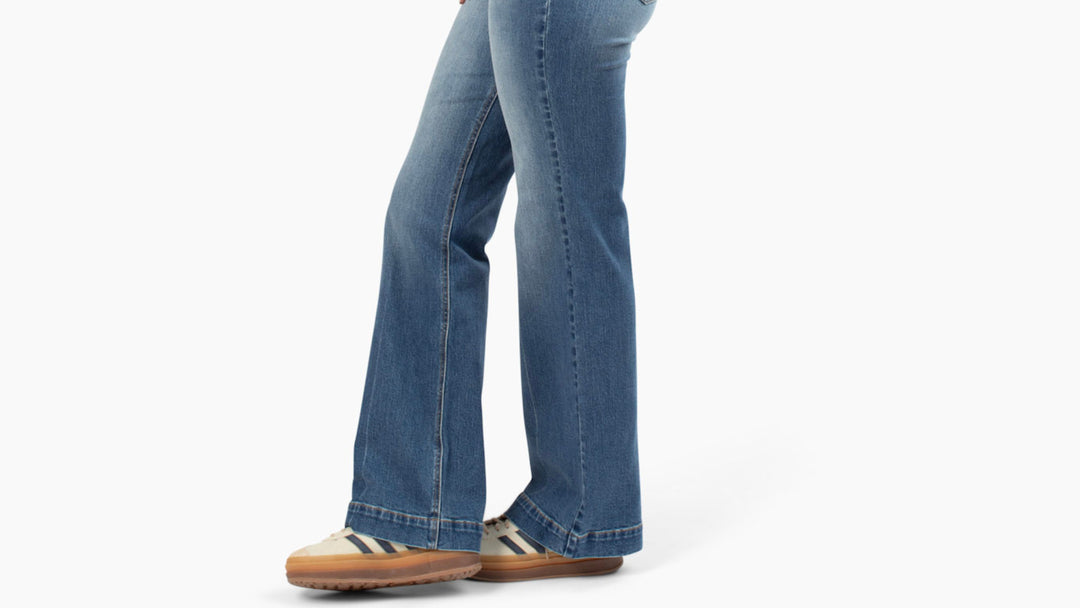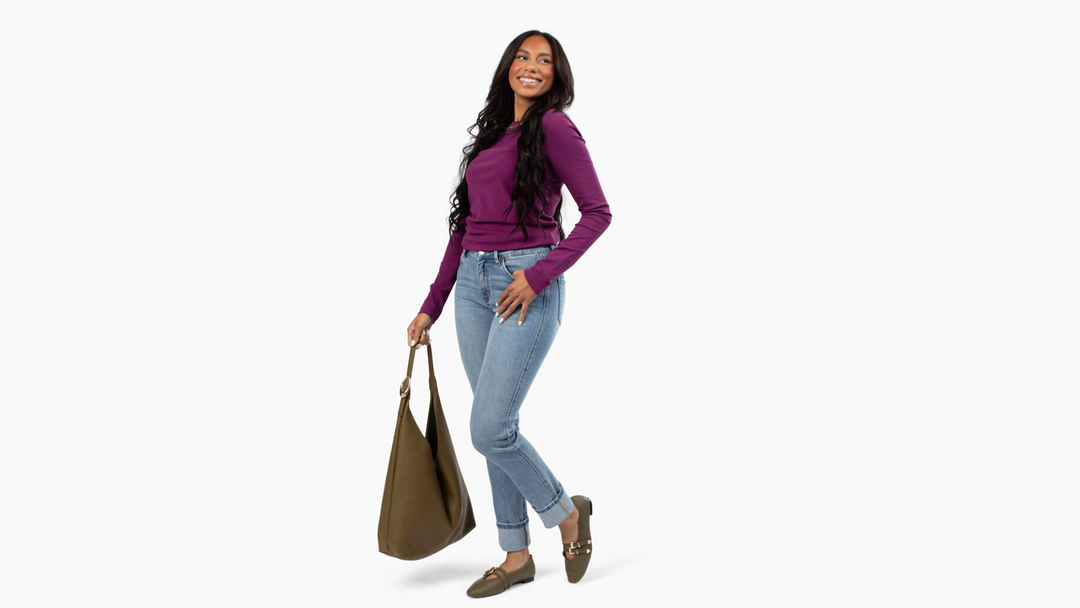Why We Hate “Tall Friendly”
Why We Hate “Tall Friendly” (and You Should Too)
We know that sounds aggressive and over the top — but it’s accurate. Trust us, it’s not because we’re hateful people.
And it’s definitely not because we haven’t gone down the “tall friendly” path ourselves, desperately trying to find clothing that actually works. We have. In fact, we lived it — maybe more than the average tall woman — because for about three years, it was the entire concept behind our first store.
We immersed ourselves in trying to buy wholesale styles that were all, quite literally, in the "tall friendly" bucket. It wasn’t a quick or haphazard experiment — we filled a 2,200-square-foot store from front to back with as many tall friendly styles across every clothing category as we could find. We traveled to every clothing market from Las Vegas to Dallas to New York, and visited showrooms in Los Angeles trying to keep it stocked.

There were challenges from the very beginning, but we were determined to make it work.
And in many ways, it did work — just not to the level we envisioned. It was good… but never great.
Not because the tall market was oversaturated or because we lacked access — we had endless contacts, relationships with top denim manufacturers, and visited the showrooms of every major brand you can name.
But “tall friendly” could only ever take us so far. The concept needed refinement, precision, and care that wholesale simply couldn’t deliver. The fit was always almost there — and for us, almost wasn’t enough.
The truth is, tall friendly will never provide the same solutions as made for tall. The little issues added up — for us as business owners and for the women wearing these clothes. Deep down, we knew it could be so much better. So we set out to create it.
With zero manufacturing experience, we pivoted from a boutique to a clothing line built specifically for tall women. And that’s where everything changed.
What “Tall Friendly” Really Means
Let’s start with what earns something the “tall friendly” label — because it can mean a few very different things.
1. The “Just Add Length” Method
This is by far the most common scenario, especially for pants. A brand takes a standard pattern and simply adds extra length to the bottom — no other proportional adjustments. This is how most “tall” pants on Amazon or from big-box retailers come to be. It’s quick, it’s cheap, and it completely ignores how tall women’s bodies are actually built.
2. When Something Just Happens to Work
Sometimes, a piece not designed for tall women kind of works — maybe it’s a looser fit, a drop-shoulder top, or a maxi dress that hits in the right spot. But that’s pure luck, not design. Because those proportions — sleeve placement, rise, waistline — were based on someone around 5’4”, it’s inevitably going to look and fit differently on you.
Our Early “Tall Friendly” Experiment (and Why We Ditched It)
As you now know, our first three years in business were spent curating the best tall friendly styles we could find. We left no stone unturned.
And we learned a lot. Nothing groundbreaking, maybe — but solid confirmation of what every tall woman already knows all too well:
-
Sleeves were sometimes long enough (or almost), but shoulders and back widths were off.
-
Pants that promised long inseams were an instant wedgie from the second you zipped them.
-
Dresses that “looked” tall online didn’t hang right once on real bodies.
-
Slits on shirts or skirts landed in awkward places.
After three years of trying to prove a tall-friendly boutique could work, we proved one thing instead:
You can’t fix the tall girl struggle with “tall friendly.”
We had to start from scratch — building our own line designed for real tall proportions. That’s exactly why we ditched everything “tall friendly” and went all in on “made for tall.”
Why It Feels (and Fits) So Different
Here’s what we learned: proportions change everything.
Tall women are not just “longer” versions of someone shorter. We have different pelvic structures, torso lengths, shoulder widths, and arm-to-body ratios. Those details determine whether a garment feels incredible… or like a constant battle.
That’s why we always say:
Close enough isn’t good enough.
True tall design means redrawing the pattern to reflect real proportions — not stretching what already exists. That’s how clothing moves with you, flatters you, and looks polished instead of “almost right.”
The Jeans & Pants Problem: It’s All in the Rise
Nothing exposes a fake “tall” pattern faster than jeans or pants.
If you’ve ever spent your day tugging at your waistband, feeling like your pants are cutting you off or creating that dreaded wedgie — that’s what happens when a brand simply adds inseam length but doesn’t adjust the rise or hip proportions.
We learned this the hard way back in our store days. We partnered with major denim suppliers, asking them to create longer inseams for us — and saw behind the curtain.

Many retailers still operate the exact same way today. They extend the length, but the rise, hip curve, and pocket placement remain unchanged.
This isn’t something we think happens — we know for a fact it does. We sat in meetings with major denim brands where decisions were made about which jean styles major retailers would buy in extended lengths… but extended length only.
We heard firsthand that nothing else would change, because altering a pattern requires reworking the entire production setup — and that means more cost, time, and higher minimums. And that wasn’t appealing to them at all.
Here’s why:
When you manufacture denim you have to cut extremely high minimum quantities per size. The pattern is created in a “fit size” first, then graded (scaled) for all other sizes. Changing anything besides inseam length affects every pattern piece — meaning the entire cutting and sewing setup has to change, too.
But if you only add length? Factories can use the same pattern and simply cut a few hundred extra units in that inseam. We were witness to the process. Major retailers would pick a very small percentage of all the overall styles available and say “Let’s do these in a 34”/36” length.” It’s faster, easier, and far cheaper. That’s exactly why the “extended length” jeans you see on Amazon, in department stores, or from boutiques that “also carry a 36-inch inseam” are — bluntly — a scam for tall women.
TL;DR: When a brand sells to everyone but suddenly offers a 36" inseam — proceed with caution.
Because we know without doubt they didn’t change the pattern and you’re wearing jeans designed for someone 5’4”. Your comfort (and sanity) will pay the price.
At Amalli Talli, every jean is tested on real tall women — including us — across heights from 5’10” to 6’4”. We refine the rise and hip fit until it moves naturally with your body and eliminates that constant tug-and-adjust feeling.
That’s how you get denim that fits everywhere — waist, hips, thighs, and length — not just one measurement.
Explore: Tall Women’s Jeans – Up to 38” Inseams
Tops & Outerwear: The Proportion Game
Back in our “tall friendly” buying days, sales reps used to say,
“This one’s too long for everyone else — it’ll definitely work for your customers!”
Ironically, that’s what many tall shoppers hear in stores, too. And sure — sometimes it worked. But most of the time, it didn’t.
“Too long” is subjective — and often not that long at all. Worse, even when the body length was decent, everything else was wrong:
-
Bust darts hit in the wrong spot.
-
Shoulder widths were narrow.
-
Tiers and patterns sat too high.
-
Hip slits and sleeve details landed awkwardly.
Length alone doesn’t make something tall.
If nothing else in the pattern is adjusted, it still won’t fit correctly across the back, shoulders, or arms. That’s why a “tall friendly” jacket can look almost right — but feel off once you move your arms or try to layer. Or it just looks ….. Not quite right.
At Amalli Talli, we reshape patterns completely — from neckline depth to sleeve drop to back width — so proportions feel balanced from every angle. Even design details like seams, cuffs, and tiers get re-evaluated to align with taller frames
Explore: Tops for Tall Women | Tall Jackets & Outerwear
Dresses & Skirts: The Overlooked Category
Dresses and skirts might look simple, but they’re often the worst offenders when it comes to “tall friendly” design.
Even when you add length, proportions still matter. A waist seam placed too high ruins the silhouette. A side slit that’s cute on a 5'4" model can become way too high on someone 6'0". Sleeve or strap lengths rarely get updated, and pattern elements like ruffles, tiers, or pockets end up floating awkwardly.
We’ve seen it all.
In our line, every dress and skirt goes through proportion testing to ensure every detail lands exactly where it should. The result? A refined, balanced look that feels like it was actually made for you — because it was.
Explore: Dresses for Tall Women
Fit Models vs. Mannequins: Real Bodies Make the Difference
If you’ve ever watched Project Runway, you’ve seen fit mannequins. They’re real — and they’re everywhere. Many fast-fashion and mass retailers rely on them to save time and money, because they can churn through hundreds of new styles a month.
Mannequins don’t need breaks, they don’t charge for fittings, and they give designers precision measurements. But here’s what they don’t give: feedback.
A mannequin can’t say, “This pulls when I sit.”
It can’t show how something moves on different heights or body types.
And again believe us when we say, sometimes what you feel is different than what the eye can see. We have been in fit meetings where they tell us something “looked good” but we were adamant that it absolutely did not feel good.
That’s why every Amalli Talli piece is tested on multiple real tall bodies — not just one. We fit across a range of heights to make sure garments work for the spectrum. And when one length doesn’t cut it, we produce multiple inseam options.
 Real fit testing in action. Every Amalli Talli piece is tried, adjusted, and refined on real tall women — not mannequins.
Real fit testing in action. Every Amalli Talli piece is tried, adjusted, and refined on real tall women — not mannequins.
That’s how you end up with clothes that don’t just fit longer — they fit better.
The Bottom Line
“Tall friendly” is fine for trends that happen to work by chance.
But for building a wardrobe you can truly count on — jeans that fit right, tops that hit right, dresses that hang right — you need clothes made for tall.
We know, because we tried every other way first.
After more than a decade in tall fashion, we can confidently say:
Real fit starts with real proportion.
Your height isn’t something to hide, fix, or just get by with — it’s something to celebrate and design for. And that’s what we’ve built Amalli Talli around.



